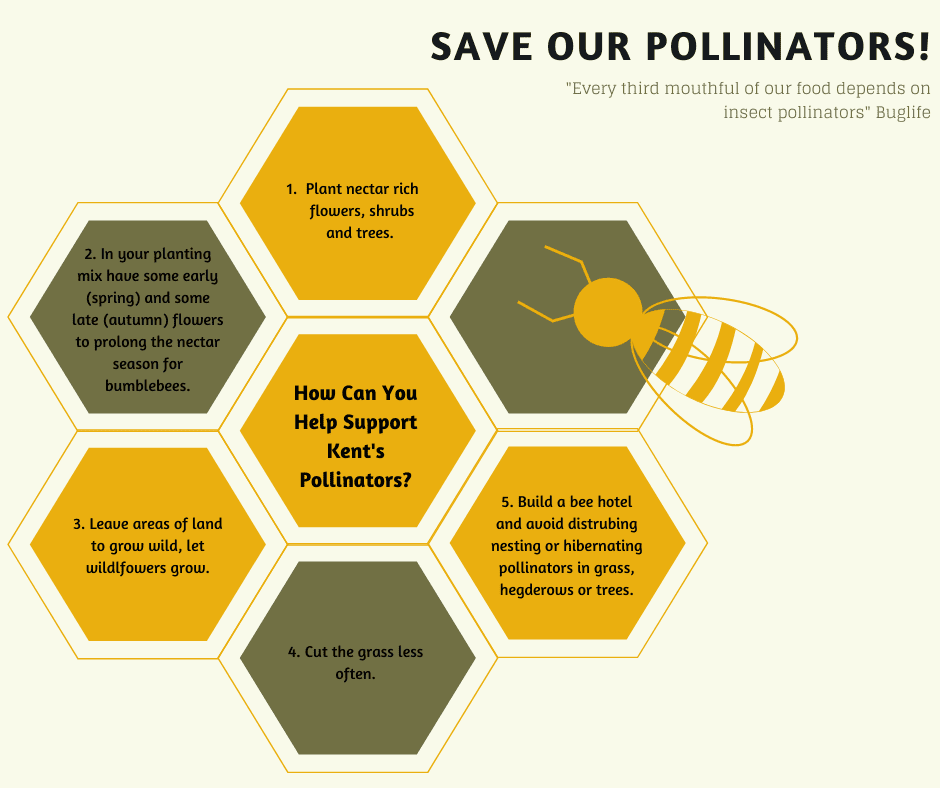What Is Plan Bee? | Wildlife At Threat

19th November 2020
What if Plan B is not the backup for Plan A, what if Plan Bee is the only one! Britain’s bees and other pollinators are in trouble, serious trouble. Approximately 35 bee species are under threat of extinction, bet you didn’t even know there were so many species of bees did you? I’ll put my hand up…I didn’t.
So, What Are Pollinators?
Your first thought may be bees and whilst you’re right, pollinators actually include bumblebees, solitary bees, wasps, butterflies, moths, hoverflies and believe it or not, mosquitos. Also it’s important to know that honeybees, the only type of bee that us humans farm, are important pollinators too in an agricultural setting but sometimes they can threaten our native, wild pollinators.
Why Are We Talking About Bees?
Because they are in trouble! Pollinators in Kent are currently suffering, some from extinction, some already lost. They carry the reproductive dust, pollen, from flower to flower to generate new plants. Without this pollen being distributed a significant number of trees and plants would not be able to reproduce.
But, How Does This Affect Me?
Well, your food primarily. Without bees, hoverflies and other insects visiting flowers there would be no strawberries, apples, avocados, chocolate, cherries, olives, blueberries, carrots, grapes, pumpkins, pears, cotton, plums, or peanuts. That is just for starters…
Really?
Yes, the environmental group Buglife says “Every third mouthful of our food depends on insect pollinators!” Plus did you know that pollinators are central to Kent’s fruit farms and guess what – 40% of Kent’s agriculture are fruit farms!
Find out how Buglife are creating B roads for bees to travel along.
What Threats Do Pollinators Suffer From?
Good question, you’re interested so let’s keep going…
The biggest reason why our bees and other friends are in decline is due to the intensification of farming. More and more pesticides are being used in farming. Intensified farming has also led to the destruction of habitats. Further loss of habitats for pollinators is due to urbanisation. Other reasons include disease and of course, climate change – these are complex threats.
Who Are Helping The Pollinators In Kent?
Kent County Council’s Plan Bee – is an action plan to help support pollinators. With 3 main objectives:
- To manage the land it owns or controls or can influence in a way which can benefit pollinators’ forage and habitat.
- To use the planning system to protect pollinators and improve the habitats on which they rely.
- To mobilise the people of Kent, to take action themselves. Kent’s Plan Bee aims to help them to greater awareness of the importance of pollinators in all our lives and everybody’s need and ability to act to protect them.
A virtual summit was held on 16th November 2020 to highlight work already under way and to bring people and organisations together to do more to help Kent’s pollinators.
Making a Buzz for the Coast – this project is to safeguard rare bees run by the Bumblebee Conservation Trust, of which Kent County Council is a partner. Making a Buzz for the Coast has created and restored habitats and linked isolated populations by creating flower-rich ‘stepping stones’ along 135 miles of the coast. It’s doing surveys of habitat and populations to build a better knowledge of the bees from Dartford to Deal.
How Can I Help?
Here are four simple actions you can take at home to help pollinators:
- Plant for pollinators: Grow more nectar-rich flowers, shrubs and trees to provide for pollinators throughout the year.
- Remember: Grow a variety of flowers in your flower mix, some that flower in spring, others in summer and more in autumn to prolong the nectar season. Visit the Kent Wildlife Trust Website for a guide on which flowers to plant.
- Let your garden grow wild: Leaving patches of land to grow wild let wildflowers grow and make great nesting and feeding sites. For advice on how to achieve this visit the Kent Wildlife Trust Website.
- Leave the lawnmower: Cut your grass less often, and remove cuttings to let plants flower.
- Build a bee hotel and avoid disturbing or destroying nesting or hibernating insects in grass margins, bare soil, hedgerows, trees, dead wood or walls. Visit the Kent Wildlife Trust Website for step by step guide on building your own bee hotel.
Popular articles
Walking the Pilgrims Way
Experience the beauty of walking across the Kent Downs NL through the…
Inspiring Pub Walks In Kent
With spring just around the corner, now is the ideal time to…
Walk Leader Volunteer Opportunity
Discover how you can become a walk leader in Medway! Uncover the…




